Migratory Bird Survey

Dan recording the results of a count.
Camp Gruber is an Oklahoma Army National Guard training center located near Muskogee, Oklahoma. A wide range of training activities takes place there for National Guardsmen and other military personnel as well as federal, state, and local law enforcement personnel. One task of the Environmental Section at Camp Gruber is to monitor and maintain environmental quality, including the health of wildlife populations and their habitats.
Over 60,000 acres (24,000 ha) of habitat are available at Camp Gruber, much of it undisturbed except for a network of rough, little used, one-lane dirt roads. About half of this total acreage is available for training use and the other half is set aside as a game management area with limited access by the public.
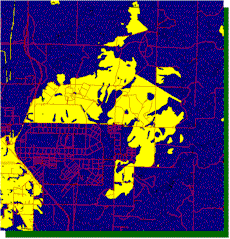
Partial map of Camp Gruber, showing roads, forests (blue), and grasslands(yellow).
The Sutton Center was contracted to conduct bird surveys along 100 m transects at 89 randomly selected points distributed between the training portion of the site and the game management area. A comparison can then be made between species diversity on the training site and that off the training site in a largely undisturbed adjacent area. Occurrence of less common species can also be evaluated to determine any preference for one or the other areas.
The surveys took place in May and June, 1998, and again in 1999. On the 89 counts surveyed in 1998, we recorded 93 bird species and approximately 2,750 individuals, including year-round residents and wintering, transient, and breeding migrants. In 1999, we recorded 81 species and 3,289 individuals.
Survey Results
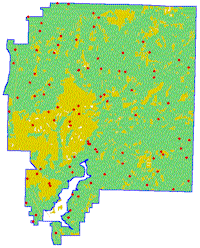 The survey of Neotropical migrant and other species of birds was carried out at Camp Gruber Training Center, Cherokee Public Hunting Area, and Cherokee Game Management Area, on 4 May to 5 June 1998, and again in 1999.The survey was made at 89 Land Condition Trend Analysis (LCTA) plots, red dots on map at left, each of which was visited twice (once in the morning and once in the evening). The observers counted all birds following the LCTA count methodology.
The survey of Neotropical migrant and other species of birds was carried out at Camp Gruber Training Center, Cherokee Public Hunting Area, and Cherokee Game Management Area, on 4 May to 5 June 1998, and again in 1999.The survey was made at 89 Land Condition Trend Analysis (LCTA) plots, red dots on map at left, each of which was visited twice (once in the morning and once in the evening). The observers counted all birds following the LCTA count methodology.
On this and the following maps, the green color indicates forested habitat, and the dark yellow indicates open habitat (grassland, urban / cantonment, and open woodland).
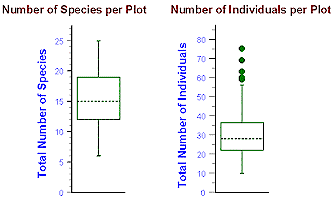
A total of 2750 individual birds of 93 species was recorded on the counts in 1998, with an additional ten species recorded at Camp Gruber, but not during the counts. The median number of species per plot was 15, with a range from six to 25. The average number of individual birds per plot was 30.9, with a range from ten to 75, but between 22 and 37 individuals were recorded on most plots.
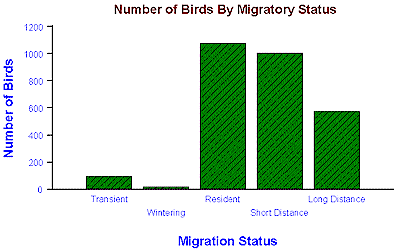
Bird species were divided into five migratory status categories. The numbers of individuals in the wintering and transient categories were low. Of the three categories in which individuals also breed at Camp Gruber, the most frequently detected were resident species, followed by short-distance and then by long-distance migrants.
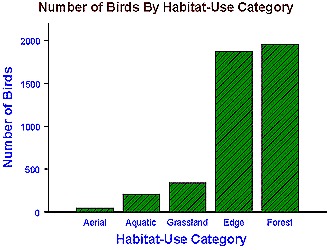 The bird species were also divided by placing them in five habitat-use categories. The greatest number of individuals was recorded in the forest habitat, with the second greatest number in edge habitats, where forest and open habitats come together. Fewer birds were recorded in the aerial (swallows and swifts), aquatic (herons, ducks, and so forth), and grassland categories.
The bird species were also divided by placing them in five habitat-use categories. The greatest number of individuals was recorded in the forest habitat, with the second greatest number in edge habitats, where forest and open habitats come together. Fewer birds were recorded in the aerial (swallows and swifts), aquatic (herons, ducks, and so forth), and grassland categories.
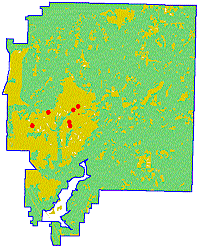 We present here a pair of maps of species showing their contrasting patterns of distribution at Camp Gruber. Dickcissels occurred only in the open habitat, specifically in the grassland.
We present here a pair of maps of species showing their contrasting patterns of distribution at Camp Gruber. Dickcissels occurred only in the open habitat, specifically in the grassland.
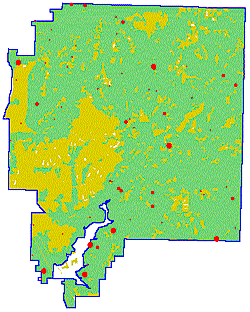 Red-eyed Vireos, in contrast, were never found in the open habitat, but only in the forested habitats.Some other species, such as Yellow-billed Cuckoo and Indigo Bunting, were found about as often in the open habitat as in the forest.
Red-eyed Vireos, in contrast, were never found in the open habitat, but only in the forested habitats.Some other species, such as Yellow-billed Cuckoo and Indigo Bunting, were found about as often in the open habitat as in the forest.
Conclusions
Camp Gruber serves as a stopover site for Neotropical migrant birds, but transient migrants composed only about 3.3 % of the total number of birds recorded during the survey. This number may belie the actual importance of Camp Gruber to transients, because transients are less likely to be detected than species breeding in the area.
The habitat diversity at Camp Gruber seems to be generally good, providing large areas of moderately-mature forest, small open patches within that forest, open woodland, much edge, grassland, urban areas in the cantonment, plus marshes, ponds, wetlands, streamsides, and aquatic habitat. This diverse mosaic of habitats provides breeding and foraging areas for many species of birds. Although the entire area probably should not be allowed to return to mature, tall trees, the current trend toward maturing of the forest should be allowed to continue over some fairly large areas.
No threatened or endangered species were recorded at Camp Gruber during this survey. Two birds, the threatened Piping Plover and the endangered subspecies Interior Least Tern, may occur in migration on the Arkansas River that forms the northwestern boundary of Camp Gruber. Possibly the most unique and rare species encountered at Camp Gruber during this survey was Henslow’s Sparrow.
Species Observed
The following table is a list of all 103 species recorded during the counts in 1998 and 1999 at Camp Gruber.
| Species | Scientific Name | Family |
|---|---|---|
| Great Egret | Ardea alba | Ardeidae |
| Cattle Egret | Bubulcus ibis | Ardeidae |
| Little Blue Heron | Egretta caerulea | Ardeidae |
| Black Vulture | Coragyps atratus | Cathartidae |
| Turkey Vulture | Cathartes aura | Cathartidae |
| Northern Harrier | Circus cyaneus | Accipitridae |
| Cooper’s Hawk | Accipiter cooperii | Accipitridae |
| Red-shouldered Hawk | Buteo lineatus | Accipitridae |
| Broad-winged Hawk | Buteo platypterus | Accipitridae |
| Red-tailed Hawk | Buteo jamaicensis | Accipitridae |
| Wild Turkey | Meleagris gallopavo | Phasianidae |
| Northern Bobwhite | Colinus virginianus | Odontophoridae |
| Killdeer | Charadrius vociferus | Charadriidae |
| Rock Dove | Columba livia | Columbidae |
| Mourning Dove | Zenaida macroura | Columbidae |
| Yellow-billed Cuckoo | Coccyzus americanus | Cuculidae |
| Eastern Screech-Owl | Otus asio | Strigidae |
| Great Horned Owl | Bubo virginianus | Strigidae |
| Barred Owl | Strix varia | Strigidae |
| Common Nighthawk | Chordeiles minor | Caprimulgidae |
| Chuck-will’s-widow | Caprimulgus carolinensis | Caprimulgidae |
| Chimney Swift | Chaetura pelagica | Apodidae |
| Ruby-throated Hummingbird | Archilochus colubris | Trochilidae |
| Red-headed Woodpecker | Melanerpes erythrocephalus | Picidae |
| Red-bellied Woodpecker | Melanerpes carolinus | Picidae |
| Downy Woodpecker | Picoides pubescens | Picidae |
| Hairy Woodpecker | Picoides villosus | Picidae |
| Northern Flicker | Colaptes auratus | Picidae |
| Pileated Woodpecker | Dryocopus pileatus | Picidae |
| Olive-sided Flycatcher | Contopus cooperi | Tyrannidae |
| Eastern Wood-Pewee | Contopus virens | Tyrannidae |
| Acadian Flycatcher | Empidonax virescens | Tyrannidae |
| Least Flycatcher | Empidonax minimus | Tyrannidae |
| Unidentified Empidonax | Empidonax sp. | Tyrannidae |
| Eastern Phoebe | Sayornis phoebe | Tyrannidae |
| Great Crested Flycatcher | Myiarchus crinitus | Tyrannidae |
| Eastern Kingbird | Tyrannus tyrannus | Tyrannidae |
| Scissor-tailed Flycatcher | Tyrannus forficatus | Tyrannidae |
| White-eyed Vireo | Vireo griseus | Vireonidae |
| Bell’s Vireo | Vireo bellii | Vireonidae |
| Yellow-throated Vireo | Vireo flavifrons | Vireonidae |
| Blue-headed Vireo | Vireo solitarius | Vireonidae |
| Warbling Vireo | Vireo gilvus | Vireonidae |
| Red-eyed Vireo | Vireo olivaceus | Vireonidae |
| Blue Jay | Cyanocitta cristata | Corvidae |
| American Crow | Corvus brachyrhynchos | Corvidae |
| Fish Crow | Corvus ossifragus | Corvidae |
| Purple Martin | Progne subis | Hirundinidae |
| Northern Rough-winged Swallow | Stelgidopteryx serripennis | Hirundinidae |
| Barn Swallow | Hirundo rustica | Hirundinidae |
| Carolina Chickadee | Poecile carolinensis | Paridae |
| Tufted Titmouse | Baeolophus bicolor | Paridae |
| White-breasted Nuthatch | Sitta carolinensis | Sittidae |
| Carolina Wren | Thryothorus ludovicianus | Troglodytidae |
| Marsh Wren | Cistothorus palustris | Troglodytidae |
| Sedge Wren | Cistothorus platensis | Troglodytidae |
| Blue-gray Gnatcatcher | Polioptila caerulea | Sylviidae |
| Eastern Bluebird | Sialia sialis | Turdidae |
| Gray-cheeked Thrush | Catharus minimus | Turdidae |
| Swainson’s Thrush | Catharus ustulatus | Turdidae |
| Wood Thrush | Hylocichla mustelina | Turdidae |
| Gray Catbird | Dumetella carolinensis | Mimidae |
| Northern Mockingbird | Mimus polyglottos | Mimidae |
| Brown Thrasher | Toxostoma rufum | Mimidae |
| European Starling | Sturnus vulgaris | Sturnidae |
| Cedar Waxwing | Bombycilla cedrorum | Bombycillidae |
| Tennessee Warbler | Vermivora peregrina | Parulidae |
| Nashville Warbler | Vermivora ruficapilla | Parulidae |
| Northern Parula | Parula americana | Parulidae |
| Yellow Warbler | Dendroica petechia | Parulidae |
| Yellow-rumped Warbler | Dendroica coronata | Parulidae |
| Yellow-throated Warbler | Dendroica dominica | Parulidae |
| Prairie Warbler | Dendroica discolor | Parulidae |
| Black-and-white Warbler | Mniotilta varia | Parulidae |
| American Redstart | Setophaga ruticilla | Parulidae |
| Prothonotary Warbler | Protonotaria citrea | Parulidae |
| Ovenbird | Seiurus aurocapillus | Parulidae |
| Louisiana Waterthrush | Seiurus motacilla | Parulidae |
| Kentucky Warbler | Oporornis formosus | Parulidae |
| Common Yellowthroat | Geothlypis trichas | Parulidae |
| Yellow-breasted Chat | Icteria virens | Parulidae |
| Summer Tanager | Piranga rubra | Thraupidae |
| Field Sparrow | Spizella pusilla | Emberizidae |
| Savannah Sparrow | Passerculus sandwichensis | Emberizidae |
| Grasshopper Sparrow | Ammodramus savannarum | Emberizidae |
| Henslow’s Sparrow | Ammodramus henslowii | Emberizidae |
| Lincoln’s Sparrow | Melospiza lincolnii | Emberizidae |
| Chipping Sparrow | Spizella passerina | Emberizidae |
| Lark Sparrow | Chondestes grammacus | Emberizidae |
| White-crowned Sparrow | Zonotrichia leucophrys | Emberizidae |
| Northern Cardinal | Cardinalis cardinalis | Cardinalidae |
| Rose-breasted Grosbeak | Pheucticus ludovicianus | Cardinalidae |
| Blue Grosbeak | Guiraca caerulea | Cardinalidae |
| Indigo Bunting | Passerina cyanea | Cardinalidae |
| Painted Bunting | Passerina ciris | Cardinalidae |
| Dickcissel | Spiza americana | Cardinalidae |
| Red-winged Blackbird | Agelaius phoeniceus | Icteridae |
| Eastern Meadowlark | Sturnella magna | Icteridae |
| Common Grackle | Quiscalus quiscula | Icteridae |
| Brown-headed Cowbird | Molothrus ater | Icteridae |
| Orchard Oriole | Icterus spurius | Icteridae |
| Baltimore Oriole | Icterus galbula | Icteridae |
| American Goldfinch | Carduelis tristis | Fringillidae |
